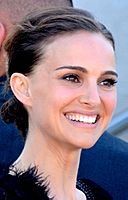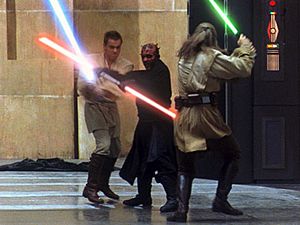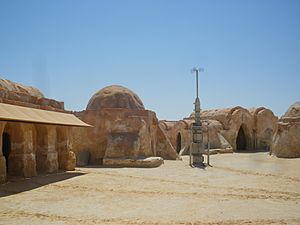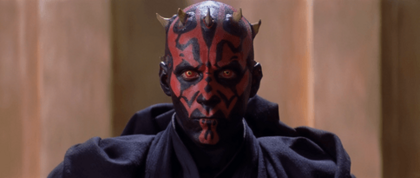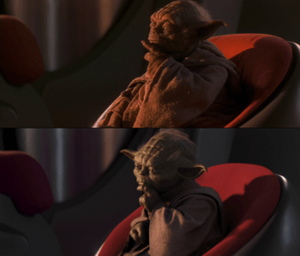Star Wars: Episode I – The Phantom Menace facts for kids
Quick facts for kids Star Wars: Episode I –The Phantom Menace |
|
|---|---|
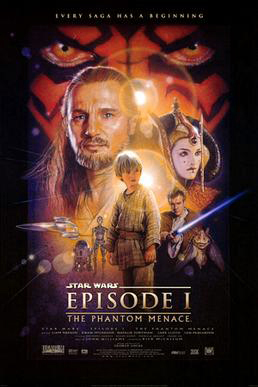
Theatrical release poster by Drew Struzan
|
|
| Directed by | George Lucas |
| Produced by | Rick McCallum |
| Written by | George Lucas |
| Starring | |
| Music by | John Williams |
| Cinematography | David Tattersall |
| Editing by |
|
| Studio | Lucasfilm Ltd. |
| Distributed by | 20th Century Fox |
| Release date(s) | May 16, 1999 (Los Angeles) May 19, 1999 (United States) |
| Running time | 133 minutes |
| Country | United States |
| Language | English |
| Budget | $115 million |
| Money made | $1.027 billion |
Star Wars: Episode I – The Phantom Menace is a 1999 American space opera film. It was written and directed by George Lucas, who also created the Star Wars universe. This movie is the fourth film in the Star Wars series, but it's the first one in the prequel trilogy. It also kicks off the story known as the "Skywalker Saga" in chronological order.
The film takes place 32 years before the original Star Wars movies. It's set during the time of the Galactic Republic, a government that kept peace in the galaxy. The story follows Jedi Master Qui-Gon Jinn and his student, Obi-Wan Kenobi. They are trying to protect Queen Padmé Amidala of Naboo to end a big trade argument. They meet a young slave boy named Anakin Skywalker, who has strong powers with something called the Force. At the same time, they face the mysterious return of the Sith, who are evil Force-users.
After the original Star Wars movies, George Lucas wasn't sure about making more films. But he had many ideas for the characters' backstories, especially Anakin's. This led him to start developing a prequel trilogy in the 1990s. He waited until computer-generated imagery (CGI) was good enough for the visual effects he wanted. Lucas began writing The Phantom Menace in 1993, and filming started in 1997. This was the first movie Lucas directed in 22 years since the first Star Wars film in 1977.
The Phantom Menace came out in theaters on May 19, 1999. People were very excited because Star Wars was so popular. Critics had mixed feelings about the movie. They liked the visual effects, but some didn't like the story's explanations or certain characters, like Jar Jar Binks. Still, the movie was a huge success at the box office. It made over $924.3 million worldwide at first, becoming the highest-grossing film of 1999. It was also the second-highest-grossing film worldwide at the time, only behind Titanic. In 2012, the movie was re-released in 3D and made even more money, bringing its total to over $1 billion. The prequel trilogy continued with Attack of the Clones (2002) and Revenge of the Sith (2005).
Contents
What Happens in the Story?
The story begins with the Trade Federation, a powerful business group, secretly blocking the planet Naboo. They plan to invade it. The leader of the Republic, Supreme Chancellor Finis Valorum, sends Jedi Master Qui-Gon Jinn and his student, Obi-Wan Kenobi, to talk with the Trade Federation's leader, Nute Gunray.
However, Darth Sidious, a secret Sith Lord who is helping the Trade Federation, tells Gunray to attack the Jedi and start the invasion with an army of battle droids. The Jedi escape and go to Naboo. There, Qui-Gon saves a clumsy Gungan named Jar Jar Binks. Jar Jar feels he owes Qui-Gon and leads the Jedi to Otoh Gunga, an underwater city where the Gungans live.
The Jedi try to convince the Gungan leader, Boss Nass, to help the people on the surface, but he refuses. Still, Jar Jar helps them get to Theed, Naboo's capital city. They rescue Queen Padmé Amidala and escape Naboo on her Royal Starship. Their goal is to reach Coruscant, the Republic's main planet.
On their way, the ship is damaged, and its hyperdrive breaks down. They land on a desert planet called Tatooine, which is outside the Republic's control. Qui-Gon, Jar Jar, the droid R2-D2, and Padmé (who is pretending to be one of her handmaidens) go to a town called Mos Espa to buy a new part. They meet Watto, a junk dealer, and his nine-year-old slave, Anakin Skywalker. Anakin is a very talented pilot and engineer who has even built a protocol droid named C-3PO.
Qui-Gon feels a very strong presence of the Force in Anakin. He believes Anakin is the special "Chosen One" who will bring balance to the Force. Watto won't take Republic money, so Qui-Gon bets both the hyperdrive part and Anakin's freedom in a dangerous podrace. Anakin wins the race and joins the group to become a Jedi, leaving his mother, Shmi, behind.
On their way back to the ship, Darth Maul, Sidious's student, attacks Qui-Gon. Maul was sent to capture Queen Amidala. After a short lightsaber fight, Qui-Gon escapes with the others.
Qui-Gon and Obi-Wan take Padmé to Coruscant so she can ask Chancellor Valorum and the Galactic Senate for help. Qui-Gon tells the Jedi Council about the Sith and asks to train Anakin as a Jedi. But the Council says no, worried that Anakin might be drawn to the dark side of the Force. Qui-Gon still promises to train Anakin as his new student.
Meanwhile, Naboo's Senator Palpatine convinces Queen Amidala to ask for a "vote of no confidence" against Valorum. This means the Senate would vote to remove Valorum and elect a new, stronger leader to solve the crisis. Amidala succeeds, but she gets frustrated with the corruption in the Senate. She decides to go back to Naboo. The Jedi Council orders Qui-Gon and Obi-Wan to go with the queen and investigate the Sith, who they thought had been gone for a thousand years.
Back on Naboo, Padmé reveals she is the real queen to the Gungans. She convinces them to join forces against the Trade Federation. Jar Jar is made a general and leads his people in a battle against the droid army. Padmé leads a search for Gunray in Theed. During a battle in the hangar, Anakin accidentally flies a starfighter into space. He ends up in a space battle against the Federation's droid control ship. He accidentally destroys it from the inside, which turns off the entire droid army.
At the same time, Darth Maul finds Qui-Gon and Obi-Wan in the Theed Palace and fights them with his lightsaber. Maul badly wounds Qui-Gon before Obi-Wan cuts Maul in half, sending him falling down a shaft. Before he dies, Qui-Gon asks Obi-Wan to train Anakin.
After the battle, Gunray is arrested. Palpatine is elected as the new Chancellor. Grandmaster Yoda makes Obi-Wan a Jedi Knight and, though he's not happy about it, agrees to let Obi-Wan train Anakin. A funeral is held for Qui-Gon. The other Jedi realize that there are always only two Sith: a master and a student. At a celebration parade on Naboo, Padmé gives a gift to Boss Nass and the Gungans, starting a new peace between their peoples.
Who Are the Characters?
- Liam Neeson plays Qui-Gon Jinn. He is a wise Jedi Master who finds Anakin Skywalker. Qui-Gon believes Anakin is the "Chosen One" who will bring balance to the Force. He insists Anakin should be trained as a Jedi, even when the Jedi Council disagrees.
- Ewan McGregor plays Obi-Wan Kenobi. He is Qui-Gon's 25-year-old Jedi student. Obi-Wan respects his master but sometimes questions his choices, especially when Qui-Gon seems to break Jedi rules.
- Natalie Portman plays Padmé Amidala. She is the 14-year-old Queen of Naboo. She wants to protect her planet from the Trade Federation's invasion. For most of the movie, she pretends to be one of her handmaidens for safety.
- Jake Lloyd plays Anakin "Ani" Skywalker. He is a nine-year-old slave boy and a very skilled pilot. He dreams of becoming a Jedi.
- Ian McDiarmid plays Palpatine. He is a senator from Naboo and secretly a powerful Sith Lord. He plans the invasion of his home planet to become the Supreme Chancellor. He is the secret villain, the "Phantom Menace."
- Ahmed Best plays Jar Jar Binks. He is a clumsy Gungan who was exiled from his home. Qui-Gon and Obi-Wan take him in.
- Anthony Daniels plays C-3PO. He is a protocol droid built by Anakin. In this movie, he doesn't have his shiny metal covering yet.
- Kenny Baker plays R2-D2. He is a brave astromech droid from Naboo who helps save Queen Amidala's ship.
- Pernilla August plays Shmi Skywalker. She is Anakin's mother. She worries about her son's future but lets him leave with the Jedi.
- Frank Oz plays Yoda. He is the very old and wise Jedi Grandmaster and head of the Jedi Council. He is not sure about training Anakin.
- Samuel L. Jackson plays Mace Windu. He is a powerful Jedi Master and a high-ranking member of the Jedi Council. He also doesn't think Anakin should be trained.
- Ray Park plays Darth Maul. He is Darth Sidious's Zabrak Sith student. He uses a cool double-bladed lightsaber. His voice was provided by Peter Serafinowicz.
- Keira Knightley plays Sabé. She is one of Queen Amidala's handmaidens and acts as her decoy for much of the film.
- Silas Carson plays Nute Gunray, the leader of the Trade Federation. He also plays Ki-Adi-Mundi, a wise Jedi Master, and Lott Dod, a Trade Federation Senator.
- Brian Blessed voiced Boss Nass, the leader of the Gungan tribe.
- Andy Secombe voiced Watto, the junk dealer on Tatooine who owns Anakin and his mother as slaves.
How the Movie Was Made
Developing the Story
When George Lucas first wrote Star Wars in 1977, he realized the story was too big for just one movie. He planned for sequels if the first film was successful. He also created a detailed backstory for the characters. In the original movies, it's revealed that Darth Vader was once Anakin Skywalker, a powerful Jedi who turned evil.
For a while, Lucas said he didn't want to make more Star Wars movies. But in the early 1990s, Star Wars became very popular again with new comics and books. Lucas saw that many people still loved the story. With new computer-generated imagery (CGI) technology, he decided to return and direct the prequel trilogy.
In 1993, it was announced that the prequels would be made. Lucas started planning the story. He decided that Anakin Skywalker, not Obi-Wan Kenobi, would be the main character. The story would be a sad one, showing how Darth Vader came to be. Anakin would grow up on Tatooine, just like his son, Luke. Lucas also changed the timeline so the prequels would show the very beginning of the long Star Wars story, starting with Anakin's childhood.
Lucas began writing The Phantom Menace in November 1994. He used a 15-page outline he wrote in 1976. Anakin was first written as a 12-year-old, but Lucas made him nine years old. He felt this younger age would better show how Anakin was affected by being separated from his mother. The movie's working title was The Beginning. It was changed to The Phantom Menace shortly before it was finished. Lucas later said the title refers to Palpatine hiding his true evil Sith identity behind the image of a helpful public servant.
The bigger budget and new digital effects allowed Lucas to think on a much grander scale. The story ended up having five main plots happening at the same time, all connected. The main plot is Palpatine's plan to become Chancellor. This leads to the Trade Federation attacking Naboo, the Jedi being sent there, meeting Anakin, and the rise of the Sith.
Lucas wanted The Phantom Menace to show several important ideas. One big idea is "duality," meaning two opposing things. For example, Amidala is a queen who pretends to be a handmaiden, and Palpatine plays both sides of the war. Another important idea is "balance." Anakin is supposedly the "Chosen One" who will bring balance to the Force.
Designing the Look
Even before Lucas started writing, his producer, Rick McCallum, began preparing for the film. McCallum decided to use digital technology to create sets and landscapes. In 1994, he started looking for artists. Doug Chiang was hired as the design director, and art development began in January 1995.
Chiang and his team spent two years creating thousands of designs. Lucas wanted Episode I to look different from the other Star Wars films. He wanted it to be "richer and more like a period piece," showing the history before A New Hope. The story takes place on three planets with different environments. Naboo has human and Gungan cities, and Coruscant has many tall buildings. The Gungan city had an art nouveau style, while other places were based on real-world designs.
Ralph McQuarrie's drawings for the original trilogy helped inspire Mos Espa on Tatooine. It was also inspired by old Tunisian hotels and had a marketplace to make it different from Mos Eisley. Coruscant's design, especially the Senate building, was also based on McQuarrie's ideas for a big city.
Terryl Whitlatch, who knew a lot about animals, designed the creatures. Many aliens were mixes of real animals. Sometimes, whole food chains were created, even if only a few creatures appeared in the movie. Whitlatch also designed detailed skeletons and facial muscles for characters like Jar Jar Binks to help the animators. Each creature's look matched its environment. Naboo's creatures were beautiful, Tatooine's were tough and leathery, and Coruscant's were human-like.
The film used a new technique called digital pre-visualization. This meant using computers to create 3D animated storyboards. This was done for many scenes, especially the podrace. The animatic supervisor, David Dozoretz, worked on the podrace for almost three years.
Stunt coordinator Nick Gillard created a new Jedi fighting style for the prequel trilogy. He compared lightsaber battles to a chess game, where every move is important. He thought Jedi would combine different sword fighting styles, like kendo, with other moves. Lucas wanted the Jedi to be "negotiators" rather than just soldiers. Hand-to-hand combat showed the Jedi's spiritual and intellectual side.
Lucas wanted detailed costumes because the society in the film was more advanced than in the original trilogy. Designer Trisha Biggar and her team made over 1,000 costumes, inspired by different cultures. Biggar worked with concept designer Iain McCaig to choose colors for each world. Tatooine had sand colors, Coruscant had grays and blacks, and Naboo had green and gold for humans, and a leathery look for Gungans. The Jedi costumes were similar to those in the original film. Biggar also made sure the costumes allowed for action scenes. A large wardrobe department at Leavesden Film Studios made 250 costumes for the main actors and 5,000 for background characters.
Filming the Movie
Filming started on June 26, 1997, and finished on September 30, 1997. Most of it took place at Leavesden Film Studios in England. The forest scenes on Naboo were filmed at Cassiobury Park in Watford, Hertfordshire. Extra scenes were shot between August 1998 and February 1999. Most of the action and stunts were filmed by a second unit team.
The Tunisian desert was used again for the Tatooine scenes. The city of Mos Espa was built outside the city of Tozeur. One night, a sandstorm destroyed many sets and props, but the team quickly fixed everything and stayed on schedule. The beautiful Italian Caserta Palace was used for the inside of the Theed City Naboo Palace for four days.
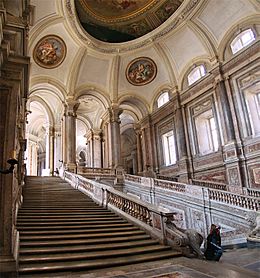
A book of storyboards guided the filming, showing which shots would be live-action, which would use a blue screen, and which would be made with CGI. Sets were often built only as high as the actors needed them. Blue screen (chroma key) was used a lot for digital backgrounds and set extensions. The cameras collected data for the CGI artists.
The Phantom Menace was the last Star Wars film shot on traditional 35mm film until The Force Awakens (2015). Some scenes, especially those with special effects, were shot on high-definition digital video tapes to test new technology. Lucas and McCallum saw digital recording as the future. All future Star Wars films would be shot using digital video cameras.
Because of all the visual effects, editing took two years. Paul Martin Smith worked on dialogue scenes, and Ben Burtt, who was also the sound editor, worked on action scenes with Lucas. They used special editing systems to constantly change and improve shots. The final sound was added in March 1999, and the movie was finished in April after all the visual effects were done.
Amazing Special Effects
"Writing the script was much more enjoyable this time around because I wasn't constrained by anything. You can't write one of these movies without knowing how you're going to accomplish it. With CG at my disposal, I knew I could do whatever I wanted".
This film was a big step forward for computer-generated effects. About 1,950 shots in The Phantom Menace have visual effects. Only one scene, where toxic gas is released on the Jedi, has no digital changes. The work was so big that three visual effects supervisors shared the tasks.
Before this film, many special effects used miniature models, painted backgrounds, and on-set tricks. But The Phantom Menace used a lot of CGI. The goal was to mix old and new techniques so viewers couldn't tell how the effects were made. New computer software was created, including programs to make digital characters' clothes look real. Another goal was to make computer-generated characters act smoothly with real actors. When filming scenes with CGI characters, Lucas would have the voice actors stand in for them. Then, the real actors would perform the scene alone, and the CGI character would be added later.
Nine R2-D2 models were made for the film. One was for actor Kenny Baker to sit in. Seven were built by ILM and could move on their own. A British studio made a special R2-D2 that could change from two to three legs, which was useful in the sand of Tunisia.
Lucas originally wanted to make many aliens with computer graphics. But some were cheaper to make with masks and animatronics. These included the Neimoidians, background characters in Mos Espa, the Jedi Council, and the Galactic Senate.
For the podrace vehicles, the visual effects team looked at old jet aircraft engines. Life-sized models of the engines were built and sent to Tunisia for reference. Except for Jake Lloyd inside a moving cockpit and a few real podracer models, the entire podracing scene was made by computers.
Themes and Ideas
Like other Star Wars films, The Phantom Menace uses ideas from history and other movies. The Star Wars movies often mix concepts from different myths, especially the "hero's journey," a common story pattern. The film also takes ideas from Ben-Hur (1959), like the podrace scene, which is similar to the chariot race.
There are also many references to Christianity. For example, Darth Maul's design looks like traditional pictures of the devil, with red skin and horns. The Star Wars story has a similar idea to the Christian story with Anakin Skywalker. He is the "Chosen One" who is supposed to bring balance to the Force, and he was born without a father.
Japanese films, like Akira Kurosawa's The Hidden Fortress (1958), influenced the original Star Wars film. The Phantom Menace was also influenced by Korean and Japanese culture. For example, Darth Maul's horns and red and black face paint are like Japanese demons. Qui-Gon's ponytail and Obi-Wan's role as a student are similar to the Samurai tradition. Queen Amidala's formal outfits and hair also have a Japanese look.
The Jedi practice Zen-like meditation and martial arts, much like ancient Japanese Samurai warriors. The name "Qui-Gon" sounds like "qigong," a Chinese practice involving meditation and using vital energy called "Chi" or "Qi" for healing and combat. In Taoist philosophy, from "The Way," yin and yang are born. These ideas come from Eastern and Iranian religions and myths.
Like other Star Wars films, themes about family and hope are very important. The music "Duel of the Fates" during the lightsaber fight between Darth Maul, Qui-Gon Jinn, and Obi-Wan Kenobi represents the fight for Anakin Skywalker's future. Qui-Gon acts like a father figure to Anakin. When Qui-Gon dies, Anakin loses this father figure. Obi-Wan becomes his master, but he doesn't act like a father, which, along with the Jedi's rules, plays a part in Anakin's future.
The Music of the Film
The music for Star Wars Episode I: The Phantom Menace was composed and conducted by John Williams, just like the other Star Wars films. He started writing the music in October 1998 and began recording it in February 1999. Williams used electronic instruments and choirs to make the sound more "magical" and "mystical" and less like military music than in the original trilogy.
One of the most famous songs is "Duel of the Fates." It uses a choir to create a religious, temple-like feeling for the epic lightsaber duel. This song even had its own music video. When Williams wrote Anakin's theme, he tried to show Anakin's innocent childhood. He also hinted at Anakin's future as Darth Vader by including small parts of "The Imperial March" in the melody.
The film's soundtrack was released on May 4, 1999. It was later released as a two-disc "Ultimate Edition" in November 2000, which included all the music heard in the film.
How the Movie Was Released
In Theaters
The release of the first new Star Wars film in 16 years caused a lot of excitement. Many people planned to skip work to see the movie on opening day. Lines formed outside movie theaters over a month before tickets even went on sale.
To make sure families could get tickets, Lucasfilm first said cinemas couldn't sell tickets in advance. But after talking with theater owners, they agreed to allow advance ticket sales starting May 12, 1999, with a limit of 12 tickets per person. Some people then sold these advance tickets for very high prices, which the filmmakers wanted to avoid.
Even though there were worries about finishing the film on time, Lucasfilm moved the release date from May 21 to May 19, 1999. Lucas said this was to give fans a "head start" during the week and allow families to see it on weekends.
The film opened at 12:01 am on Wednesday, May 19, 1999, in 2,010 theaters in the United States and Canada. Another 960 theaters showed the film later that day. About 120 theaters showed the film continuously on opening day. Lucas also said the film would be shown on four digital projectors in New York and Los Angeles starting June 18, 1999, testing new digital film technology.
On Home Video
The film was released on VHS on April 4, 2000, in both standard and widescreen versions. In its first two days, it sold 4.5 million copies. On October 16, 2001, The Phantom Menace became the first Star Wars film to be released on DVD. This two-disc DVD included a slightly longer version of the film. The second disc had special features, like seven deleted scenes, a commentary track with Lucas, and documentaries, including The Beginning: Making Episode I.
The Phantom Menace became the fastest-selling DVD ever in the United States, selling 2.2 million copies in its first week. It earned $45 million from its first week of DVD sales.
The DVD version was re-released in a prequel trilogy box set on November 4, 2008. The Star Wars films were released on Blu-ray Disc on September 16, 2011. For the Blu-ray release of The Phantom Menace, the puppet version of Yoda was replaced with a CGI model to match the other prequel films.
On April 7, 2015, all six Star Wars films were released digitally. The Phantom Menace became available on services like iTunes Store and Amazon Video. It was also reissued on Blu-ray, DVD, and digital download on September 22, 2019. All six films became available in 4K HDR and Dolby Atmos on Disney+ when it launched on November 12, 2019. A 4K Ultra HD Blu-ray box set was released on March 31, 2020.
3D Re-release
On September 28, 2010, it was announced that all six Star Wars films would be converted to 3D. They would be re-released in order, starting with The Phantom Menace on February 10, 2012. However, the 3D re-releases of the other films were put on hold after Lucasfilm was bought by The Walt Disney Company, who wanted to focus on making Star Wars: The Force Awakens.
Lucas said the 3D re-release was just a conversion of the 2011 Blu-ray version, with no major changes. Only a small change was made to Anakin's magnetic wand during the podrace scene.
What Came After
A sequel, Attack of the Clones, was released in 2002. The story continues ten years later with Anakin as an adult, played by Hayden Christensen. A second sequel, Revenge of the Sith, came out in 2005. This film shows Anakin's full transformation into Darth Vader.
A month after the film's release, "Weird Al" Yankovic released a funny song and music video called "The Saga Begins." In it, he tells the movie's story from Obi-Wan's point of view, set to the tune of "American Pie."
In 2018, Natalie Portman appeared in a comedy rap video on Saturday Night Live. She played Queen Amidala again and defended the prequel trilogy.
This film also started the Lego Star Wars toy line, which has become one of Lego's most successful licensed brands.
Darth Maul's lightsaber fighting style inspired the 2003 viral video Star Wars Kid. Maul, who seemed to die in The Phantom Menace, was brought back for the animated series Star Wars: The Clone Wars and also appeared in Star Wars Rebels and Solo: A Star Wars Story. In 2012, IGN named Maul the 16th-greatest Star Wars character. A weapon similar to his double-bladed lightsaber appears in Star Wars: The Rise of Skywalker.
See also
 In Spanish: Star Wars: Episodio I - La amenaza fantasma para niños
In Spanish: Star Wars: Episodio I - La amenaza fantasma para niños




